This is a story of some very naughty dentists, professors at University of California Los Angeles (UCLA) in USA. Their creative stem cell research and publishing activities in top-level journals brought them and their faculty some serious money, but it seems the success was built on manipulated research data. This is why a bizarre thing is happening: while UCLA research integrity and even Title IX officers investigate, the UCLA School of Dentistry dean, the Vice-Chancellor and the UCLA Provost opened a witch-hunt on the whistleblower, a professor at UCLA who will remain unnamed for now.
The key figure accused of publishing manipulated data is the associate dean Cun Yu Wang, previously regarded as a scientific superstar in his home country China. Another specifically fingered faculty member is Wang’s former mentee and now associate professor Christine Hong, while their coauthors, senior associate dean Sotirios Tetradis and faculty head dean Paul Krebsbach, are accused of retaliation and sweeping things under the rug.
There have already been several corrections. In one case, a 2018 Cell Stem Cell paper was found so badly rigged, dirty tricks had to be used by the publisher Elsevier to help authors avoid a retraction. The two-pronged approach by UCLA seems to be: correct for fake data as quietly as possible, while persecuting the whistleblower. That is because there is some serious money involved. Over $32 million of NIH funding are associated to the accused scientists, a total of 16 NIH R01 grants. These are: R01AR063089, R01DE015964 (1 original and 2 renewal grants), R01DE016513 (1 original and 2 renewal grants), R01DE017684, R01DE019412 (1 original and 2 renewal grants), R01DE024828, R01DE028260 and R37DE013848 (1 original and 2 renewal grants).
This is the sequence of events:
17.07.2018: The whistleblower filed a Title IX report about a senior faculty member for alleged harassing of a student, after the whistleblower was informed by that student. At around same time, the student filed her own Title IX report.
28.08.2018: The whistleblower raised new concerns to the Vice Chancellor Michael Levine regarding the unethical behaviour of the associate dean – Cun Yu Wang. the whistleblower has been communicating with Levine since May 2016 regarding the alleged unethical behaviorWang and his collaborators in the UCLA School of Dentistry
13.11.2018: The whistleblower lodges a formal complaint against the dean and associate deans of the dental school. with Ann Pollack, assistant vice chancellor – Research and Campus Research Compliance Coordinator regarding scientific fraud by the dean and associate deans of the UCLA School of Dentistry. Whistleblower has since been actively working with Pollack on collecting evidence as she requested.
29.11.2018. An anonymous email is sent to all faculty members, listing evidence of data manipulation in papers by Wang and Hong, the case was also summed up on a Chinese website.
10.01.2019: The whistleblower was forced to step down as department chair by dean Krebsbach. The following day, dean Krebsbach allegedly further retaliated against the whistleblower in the Chairs’ Meeting in front of all the other chairs by making openly abusive and humiliating statements, e.g laughing: “I am giving the new chair the key to the Mercedes”.
16.01.2019 The whistleblower was allegedly verbally attacked and loudly threatened by Wang in a parking lot. Wang was quoted to have said multiple times “you tried to hurt me, and now you got hurt” and added “if you don’t stop, you will get hurt again”. There were witnesses.
March 2019: the Title IX student formally sued the university. The whistleblower serves as witness for her.
16.04.2019: The whistleblower received a letter from Vice Chancellor Scott L. Waugh cc-ed to every faculty member at the School of Dentistry. On 30.04.2019 however, an announcement was made that Waugh resigns as Vice Chancellor. The letter said:
“Dear Colleagues:
As you may know, numerous complaints brought to the attention of the administration and Senate have asserted serious concerns about the management of some sections of the School of Dentistry. The concerns appear to have broadly affected the atmosphere, culture and climate in the School, hampering the School’s functioning and progress. Therefore, after consulting with the Vice Chancellor for Academic Personnel, the Vice Chancellor for Equity, Diversity and Inclusion, the Dean of the School of Dentistry, the Academic Senate’s Privilege and Tenure Committee as well as with Academic Senate leadership more broadly, I have decided to undertake actions aimed at resolving the issues raised and better understanding any structural problems within the School that may have contributed to the problems.
In order to allow a broader independent review of the situation, a group comprised of faculty from the School of Dentistry and the School of Medicine has been formed to evaluate and oversee the situation and serve pro tem as leadership for the Division of Growth and Development and the Section of [XXXX]. The members of this group will serve as advisors and report to me, will seek counsel and information from members of the School of Dentistry administrative leadership team, and function as the Division Chair and Section Chair. In addition, an outside firm will be engaged to investigate various issues, first in [XXXX] and then in other sections as necessary. My hope is that such a change in internal leadership along with a thorough understanding of their operations will improve the climate of the Division and Section, and in the School of Dentistry overall.
The four faculty members who will comprise this group of advisors are: [Four faculty members are named and described, -LS]
This action will not substitute for or interfere with any investigations that must proceed entirely independently. Any allegations of University policy violations will be processed pursuant to standard procedures used by various investigatory units, such as the Discrimination Prevention Office, Title IX Office, and the appropriate Academic Senate judicial committees.
I thank you in advance for your full support and cooperation with this action. The group will begin its work today, April 16th, and will remain in place for the foreseeable future. During the process, I plan to consult with all appropriate constituents, including the leadership of the School of Dentistry, relevant vice chancellors, and relevant Academic Senate Committees.
I am taking this action because of my strong support for the welfare of the faculty of the School of Dentistry. I am grateful for the continued leadership of Dean Krebsbach and for the vision he and his administrative team crafted together with the FEC and the School’s faculty. I trust this action will provide timely and valuable insight into how the School and its extraordinary scholars can productively focus on their core missions of research, teaching and clinical service.”
Next day, Dean Krebsbach feeling emboldened from the very top, sent this email to the faculty, with the subject “Administrative Issues”:
“Dear UCLA Colleagues,
I am writing to update you on several changes that will be taking place in the Division of Growth and Development and the Section of [XXXX]. The necessity for these changes has arisen from a large number of charges, complaints, and allegations that have been made over the last several years. The Academic Senate and the Executive Vice Chancellor/Provost determined that the gravity of the situation required intervention to address it directly.
Therefore, effective immediately, a new group of experienced School of Medicine and School of Dentistry faculty will assume the roles of Interim Chair of the Division of Growth and Development and Interim Chair of the Section of [XXXX]. […]
Executive Vice Chancellor Scott Waugh has addressed this matter in detail, and his letter is attached to this message. You can relay the general information from this letter to your staff and residents if you feel it is necessary for your daily functions. However, I ask that you do not share the EVCs letter with anyone. […]
You may receive communications that appear to place blame or attack the plan outlined by the Academic Senate and the Executive Vice Chancellor. If you are on the receiving end of such communications, I urge you to withhold judgment and allow the process to run its full course. These processes are well-established in University policy, are confidential, and can take a long time to resolve.”
Now follows what that whistleblower-witchhunt is about. On top of Title XI complaint, there are some very serious issues of manipulated data in these dentistry research papers. Recline in your chair, open wide and for your own sake, don’t squeal, or you will get hurt. UCLA dentists will treat you now to something special.
1. Christine Hong, Alison Quach, Lawrence Lin, Jeffrey Olson, Taewoo Kwon, Olga Bezouglaia, Jaime Tran, Michael Hoang, Kimberly Bui, Reuben H. Kim, Sotirios Tertradis
Local vs. systemic administration of bisphosphonates in rat cleft bone graft: A comparative study.
PLoS One. (2018) doi: 10.1371/journal.pone.0190901.
2. Nicole Cheng, Juyoung Park, Jeffery Olson, Taewoo Kwon, Deborah Lee, Rachel Lim, Sandy Ha, Reuben Kim, Xinli Zhang, Kang Ting, Sotirios Tetradis, Christine Hong
Effects of Bisphosphonate Administration on Cleft Bone graft in a Rat Model.
Cleft Palate Craniofac J. (2017) doi: 10.1597/15-356.

The authors will probably explain that it all was part of same experimentla series, hence the reuse of “Control” bone image was justified. Yet note that the image for “Graft/Saline” which is actually another kind of control (for the experimental intervention) was not reused. This means these are different experiments after all. Maybe for some reason the authors lacked a control for the PloS One paper, so they used one from an older experiment, because who cares.
3. Yongxin Tu, Peng Deng, Bo Yu, John M. Szymanski, Tara Aghaloo, Christine Hong, Cun-Yu Wang
Inhibition of EZH2 Promotes Human Embryonic Stem Cell Differentiation into Mesoderm by Reducing H3K27me3
Stem Cell Reports (2017) doi: 10.1016/j.stemcr.2017.07.016
The evidence for Figure S2A was also posted on PubPeer, on 30.10.2018:
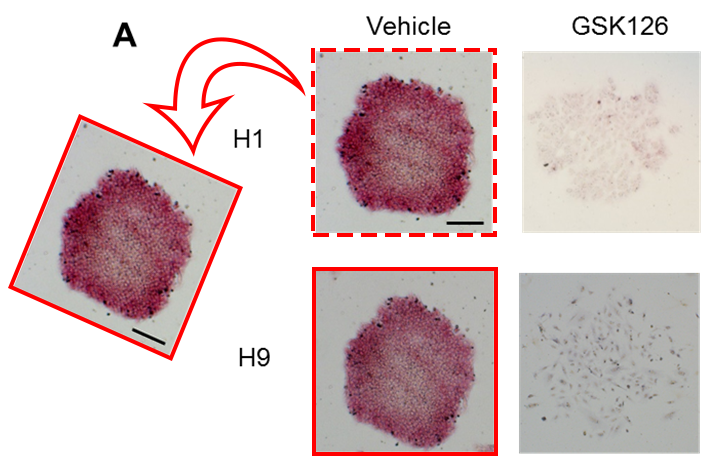
Wang replied on PubPeer just 2 days later:
“Thank you very much for altering this error. We immediately contacted the co-first authors. We were able to locate the raw images for the related experiments. As it turns out, the similar field of H1-vehicle cells was imaged twice, one of which was saved under the wrong folder by mistake. The first author mistakenly took the image from the wrong folder as she assembled the figure. We have contacted the Journal for corrections.”
Interesting mistake, to copy-paste, then slightly rotate and crop the image, then adjust intensity and blame it on co-first authors.
4. Peng Deng, Chenchen Zhou, Ruth Alvarez, Christine Hong, Cun-Yu Wang
Inhibition of IKK/NF-κB Signaling Enhances Differentiation of Mesenchymal Stromal Cells from Human Embryonic Stem Cells
Stem Cell Reports (2016) doi: 10.1016/j.stemcr.2016.02.006.
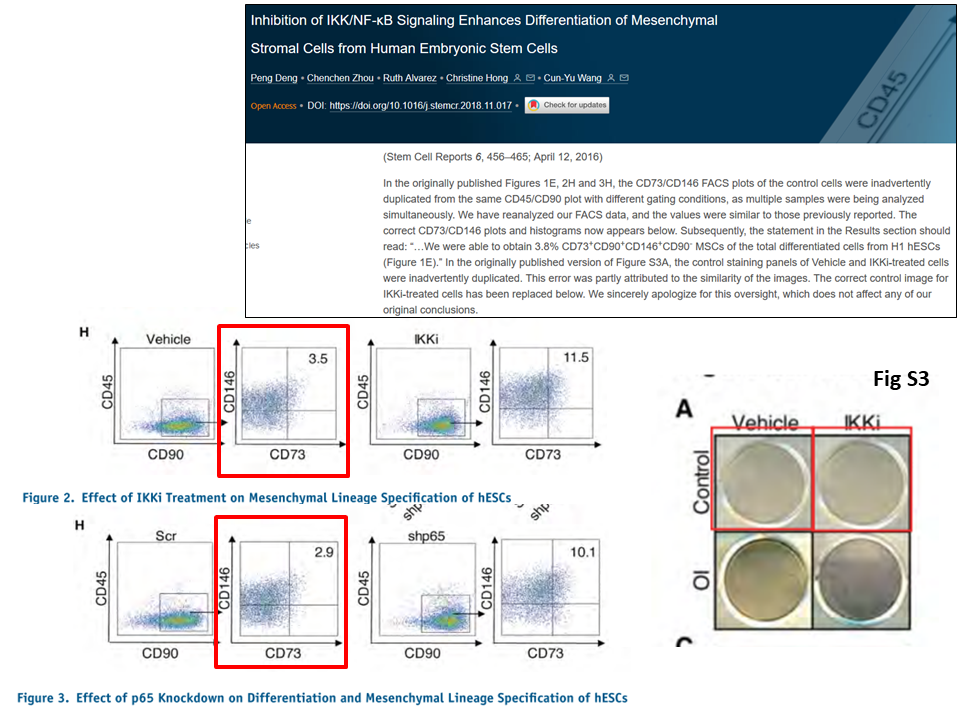
On 9.01.2019, the journal Stem cell Reports issued a correction.:
“In the originally published Figures 1E, 2H and 3H, the CD73/CD146 FACS plots of the control cells were inadvertently duplicated from the same CD45/CD90 plot with different gating conditions, as multiple samples were being analyzed simultaneously. We have reanalyzed our FACS data, and the values were similar to those previously reported. […] In the originally published version of Figure S3A, the control staining panels of Vehicle and IKKi-treated cells were inadvertently duplicated. This error was partly attributed to the similarity of the images. The correct control image for IKKi-treated cells has been replaced below. We sincerely apologize for this oversight, which does not affect any of our original conclusions.”
The first sentence should have rung alarm bells. “Different gating conditions”? Authors basically admit to have been manipulating their flow cytometry data by arbitrarily tweaking the settings for each sample, instead of adhering to same gating setup throughout data acquisition (read about a related case here). Yet the journal (published by the International Society for Stem Cell Research, ISSCR), had no quarrel with that. In this case, conclusions are indeed unaffected because the image duplication was just a minor issue in a bigger scheme of rigged data acquisition.
5. Ruth Alvarez, Hye-Lim Lee, Christine Hong, Cun-Yu Wang
Single CD271 marker isolates mesenchymal stem cells from human dental pulp
Intl J Oral Science (2015) doi: 10.1038/ijos.2015.29
The issue with Figure 1 was presented on PubPeer on 30.10.2018:
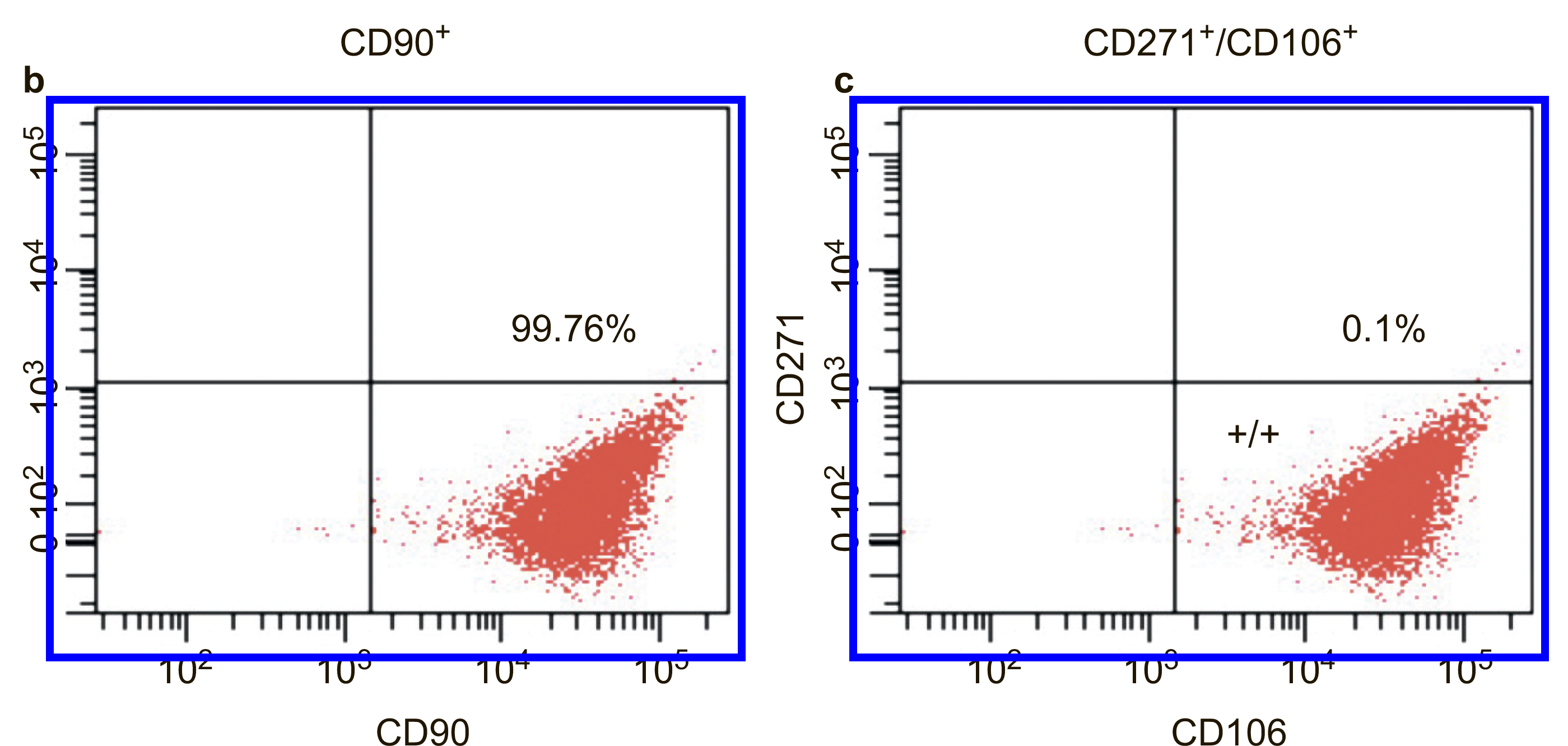
The flow cytometry experiments are supposed to be clearly different, as cells were probed for different membrane proteins. Yet the FACS file analysed was the same, the signal shows CD90 in one case and CD106 in another. This can unlikely be an innocent mistake of oversight.
6. Yinhduan Cheng, Quan Yuan, Laurent Vergnes, Xin Rong, Ji Youn Youn, Jiong Li, Yongxin Yu, Wei Liu, Hua Cai, Jiandie D. Lin, Peter Tontonoz, Christine Hong, Karen Reue, Cun-Yu Wang
KDM4B protects against obesity and metabolic dysfunction
PNAS (2018) doi: 10.1073/pnas.1721814115
As posted on PubPeer on 30.10.2018 for Figure 1:
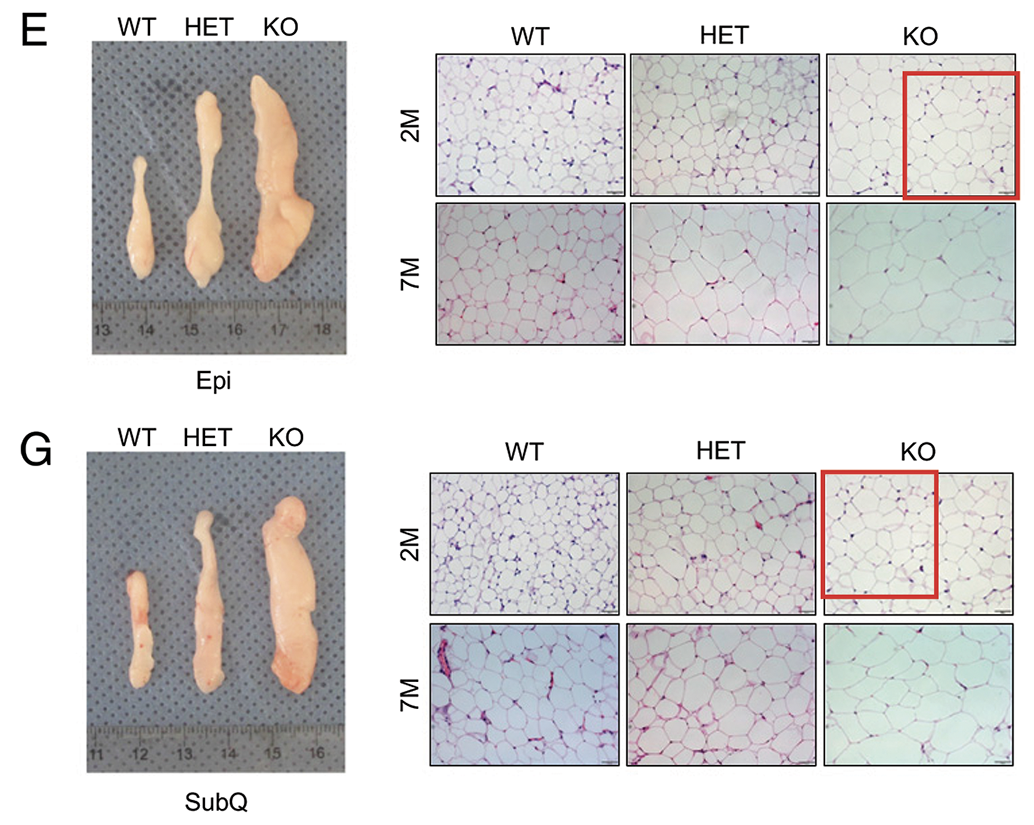
The PNAS paper was corrected on 5.02.2019:
“The authors note that, in Fig. 1G, the image for s.c. fat of 2M KO mouse appeared incorrectly. The authors inadvertently used an image of epidermal fat from the same mouse.”
Apparently, reusing same large-field image while picking a different, shifted area, goes as “inadvertently” these days. One wonders if PNAS verified the time stamps on the original replacement image? Did the editors even asked for raw data of this 2018 paper, or was a new corrected figure sent as pdf enough?
7. Bo Yu, Lihong Huo, Yunsong Liu, Peng Deng, John Szymanski, Jiong Li, Xianghang Luo, Christine Hong, Jiandie Lin, Cun-Yu Wang
PGC-1α Controls Skeletal Stem Cell Fate and Bone-Fat Balance in Osteoporosis and Skeletal Aging by Inducing TAZ
Cell Stem Cell (2018) doi: 10.1016/j.stem.2018.06.009
That was a beautiful case, dealt with in typical way of Elsevier’s Cell Press, expert recidivists in hiding and fostering data fakery (see other examples here and here). Cell Stem cell quietly asked the authors to replace the published paper with a new version, where all the manipulated figures were “fixed”. All you find in “publication history” is:
“Published: July 12, 2018; corrected online: September 10, 2018”
However, and here comes the irony Elsevier will appreciate: those readers without paywall access will go to the pirate site Sci-Hub, and it hosts the original version of the paper from August 2, 2018, with all the manipulated data neatly still in place.
The evidence was posted on PubPeer in August 2018:
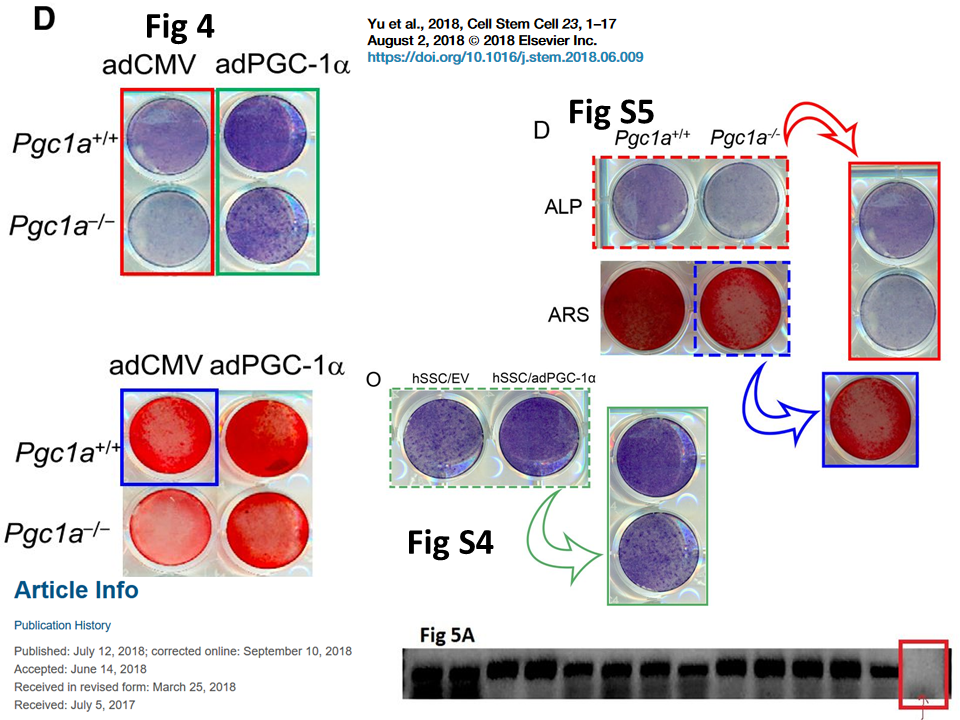
You cannot explain stuff like that with innocent mistakes, the reused and brightness-adjusted images of wells or the fabricated last lane of the gel in Figure 5A. There was even more:
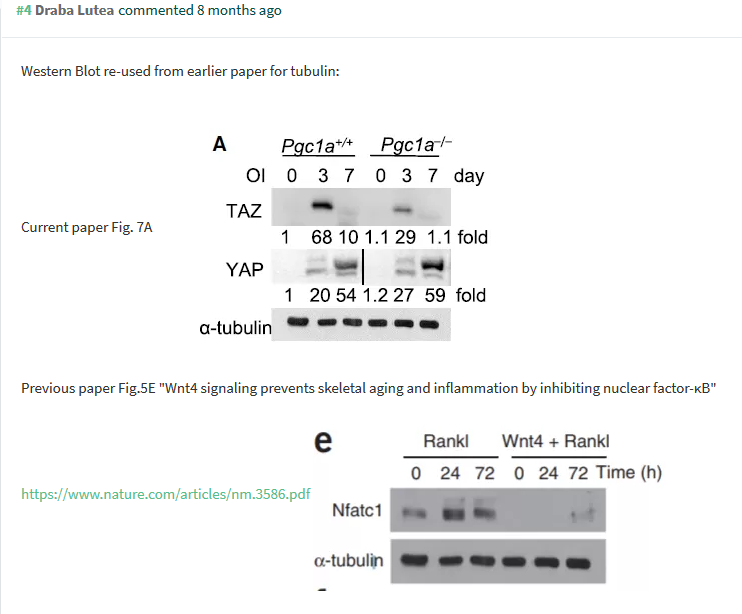
First of all, the YAP gel in Figure 7A lacks a loading control, the authors even openly admit in the figure legend: “The YAP image was cropped from two parts of the same blot, with two irrelevant lanes removed”. Nobody at Cell Stem Cell cared. Whatever the authors loaded on the YAP gel, there is no loading control for it. This went as high impact science in this Cell family elite journal in the year 2018. In fact, there is no loading control at all, not even for TAZ, because the tubulin gel most obviously belongs to the utterly unrelated samples of Figure 5E of this paper:
Bo Yu, Jia Chang, Yunsong Liu, Jiong Li, Kareena Kevork, Khalid Al-Hezaimi, Dana T Graves, No-Hee Park & Cun-Yu Wang
Wnt4 signaling prevents skeletal aging and inflammation by inhibiting nuclear factor-κB
Nature Medicine (2014) doi: 10.1038/nm.3586.
That paper received in 2015 an Addendum, where authors admit to have rigged the statistics. What should have more than sufficed for a shameful retraction, didn’t even make a correction:
“In the published article, we, the authors, interpreted the data in Figure 4a–e to mean that transgenic expression of Wnt4 in osteoblasts of mice protects them from age-related bone loss. However, after publication it has been pointed out to us that, at all the ages examined, the transgenic mice had greater trabecular bone mass than control mice. Thus, we have re-examined the data in Figure 4b using statistical tests to examine the relative rate of change of bone mass and bone volume/total volume over the four age groups presented, and we find there is no statistical difference for the rate of these parameters between the transgenic and control groups. Thus, our conclusions with respect to this aspect of the study were incorrect, and further we conclude that we placed an improper emphasis on these findings in the title of the paper.
We have also reanalyzed the data in the rest of the paper using more proper statistical tests in several instances. In particular, the standard deviations in Figures 1g, 1h, 2c–e, 3c–e, 4d, 4f, 6d, 6e and Supplementary Figure 6g were reported inappropriately. We used values from each histology image (3–6 images per mouse) as individual data points, instead of the mean values for each mouse, leading to an increased standard deviation. Furthermore, for morphometric and serum analysis in Figures 2, 3, 4g,h, 6 and Supplementary Figure 6, one-way analysis of variance with Tukey’s post hoc test should have been used to account for multiple comparisons and adjustments for type I errors. Upon reanalysis, the comparison of osteoclast numbers/bone surface between the wild-type (WT) sham group and the Ob-Wnt4 sham group in Figure 2e, and the comparison of osteoclast surface/bone surface between the WT and Wnt4 groups in Figure 3e lost statistical significance, as was stated in the article.
Although our conclusion about the effect of transgenic expression of Wnt4 in osteoblasts on skeletal aging appears to be incorrect, the above changes regarding our statistical analyses do not alter the conclusions drawn in the manuscript with respect to the effect of Wnt4 transgenic expression on bone mass compared to non-transgenic mice at static time points, the effect of recombinant Wnt4 on bone loss in the ovariectomy model nor on the molecular mechanisms for these effects. Nonetheless, we apologize for any confusion these original analyses or conclusions may have caused.”
Now you understand what kind of dentists Wang, Hong, Tetradis and Krebsbach are. Whatever activities they engage in, they enjoy full support from UCLA, as well as from both Nature and Cell Publishing Groups. Don’t mess with them or, as Wang said, you will get hurt.
Update 29.05.2020
The campus newspaper Daily Bruin now reported about the affair. The whistleblower is named as Kang Eric Ting, the article also addresses accusations of sexual harassment raised by Ting’s student against Tetradis, which were originally reported on my site a year ago. Ting is now suing UCLA for retaliation.
Meanwhile, more data fakery in Cun-Yu Wang‘s papers was flagged on PubPeer by Elisabeth Bik:
Bik also found more fake data in the Yu et al Cell Stem Cell 2018 paper:
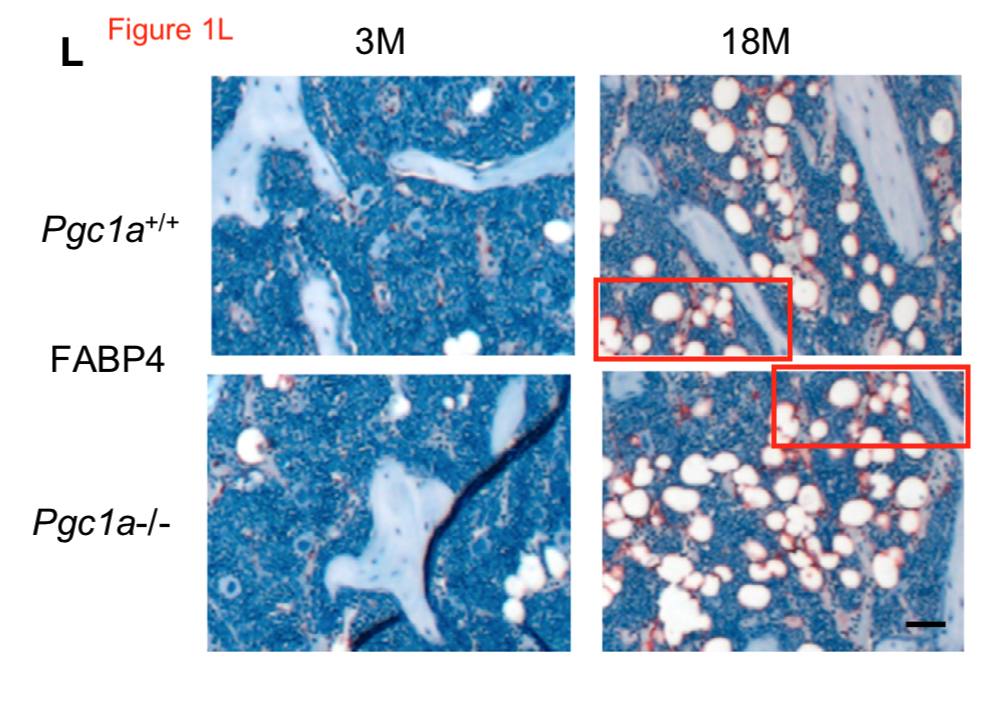
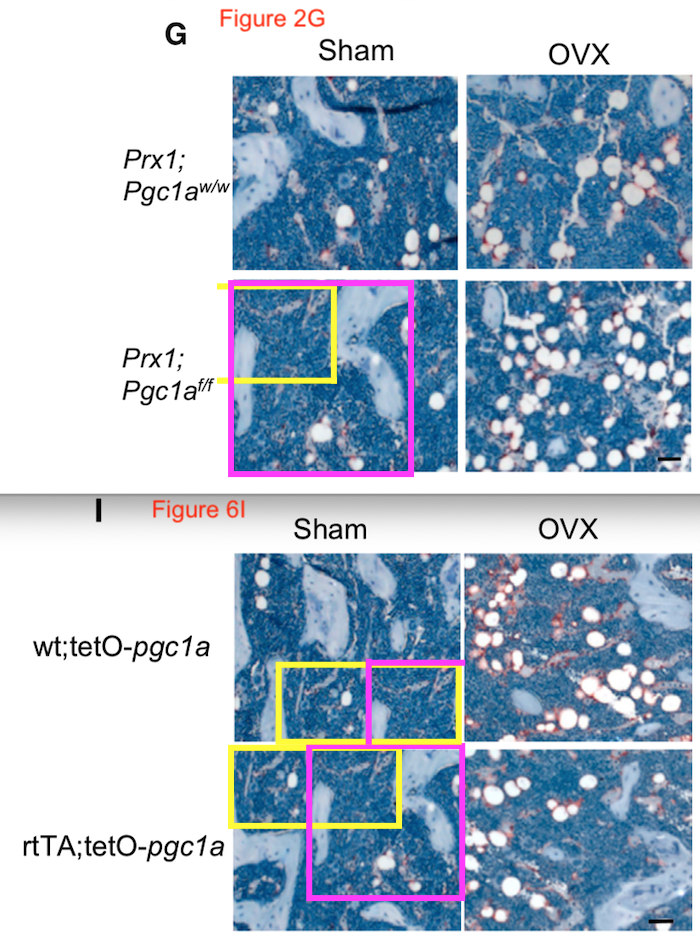
And this beauty:
J Wang , J Wang , J Dai , Y Jung , CL Wei , Y Wang , AM. Havens , PJ. Hogg , ET. Keller , KJ. Pienta , JE. Nor , CY Wang , RS. Taichman A glycolytic mechanism regulating an angiogenic switch in prostate cancer Cancer Research (2007) doi: 10.1158/0008-5472.can-06-2971
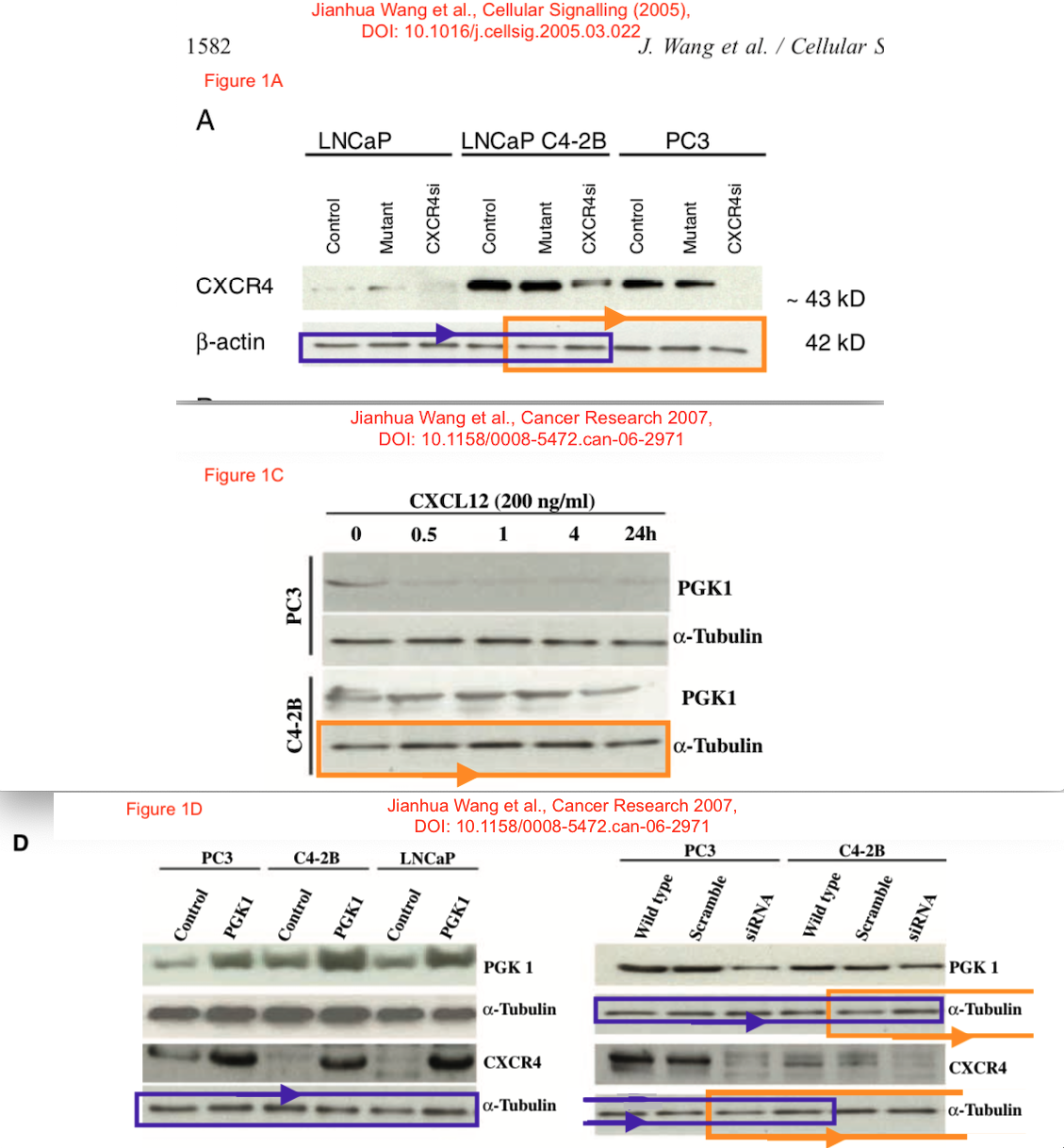
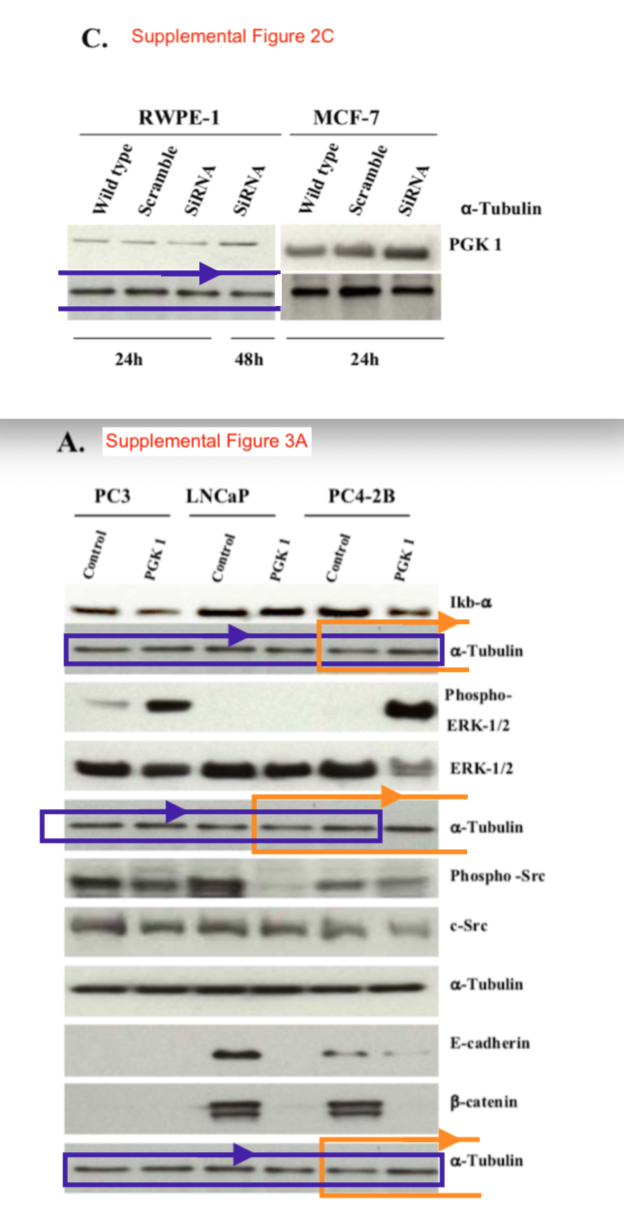
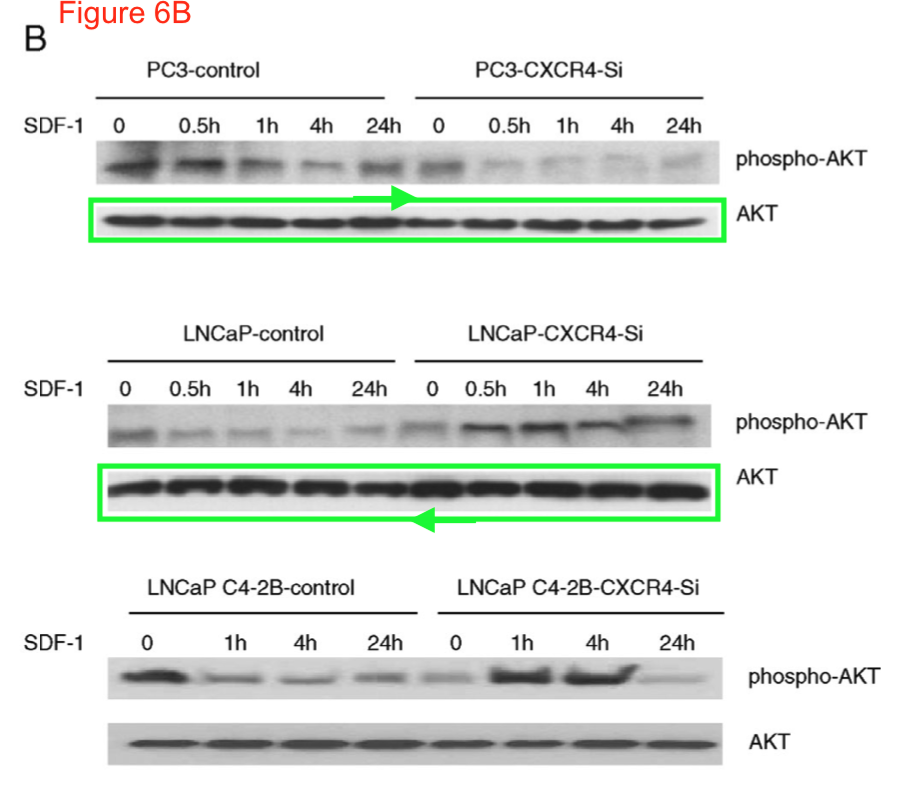

Donate!
If you are interested to support my work, you can leave here a small tip of $5. Or several of small tips, just increase the amount as you like (2x=€10; 5x=€25). Your generous patronage of my journalism will be most appreciated!
€5.00

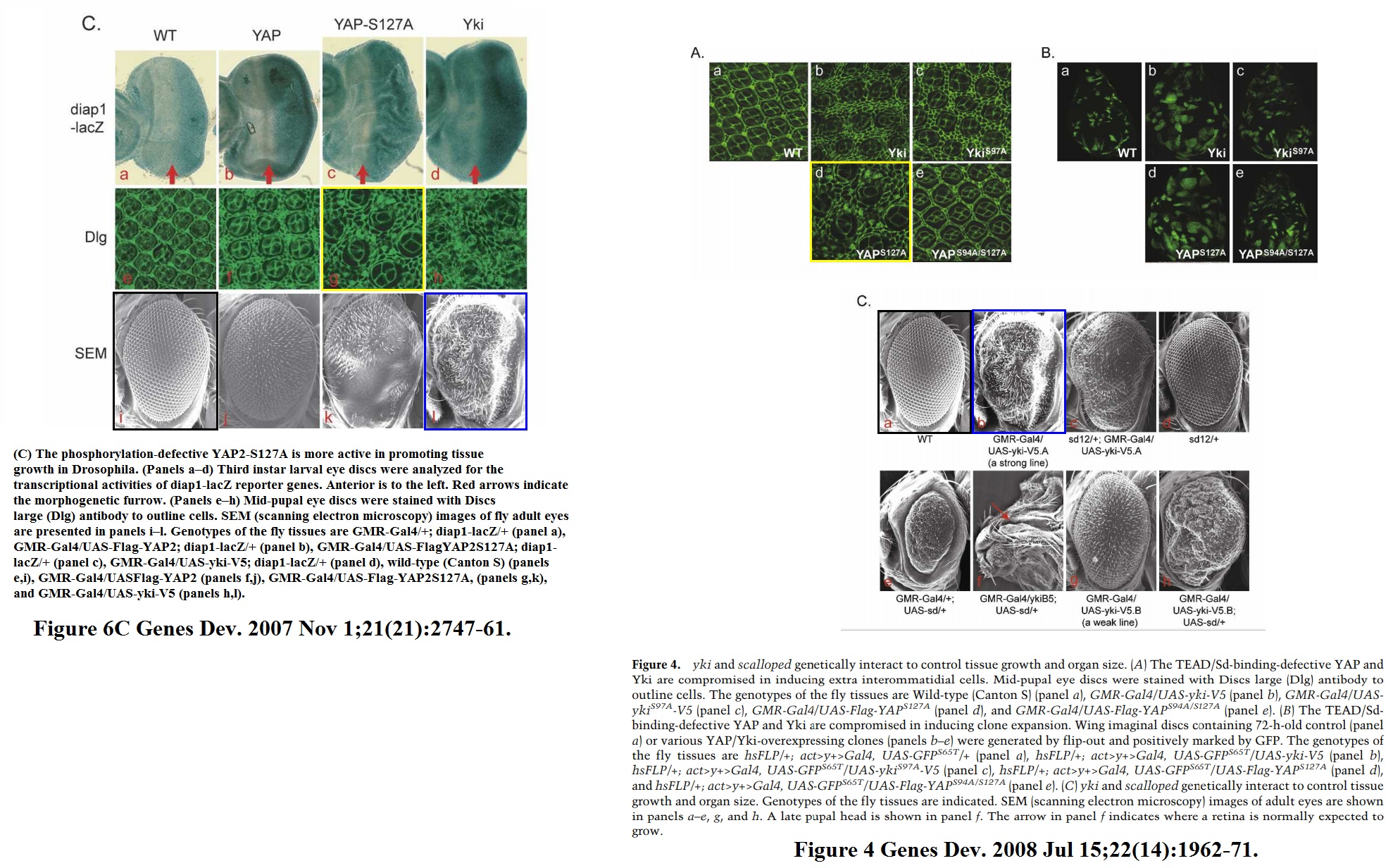
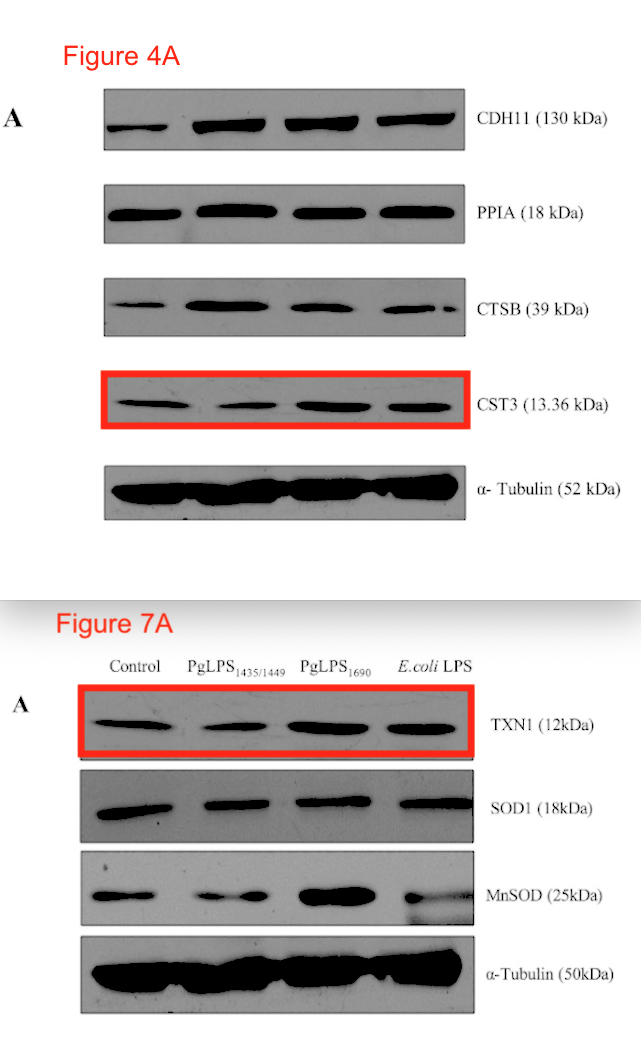

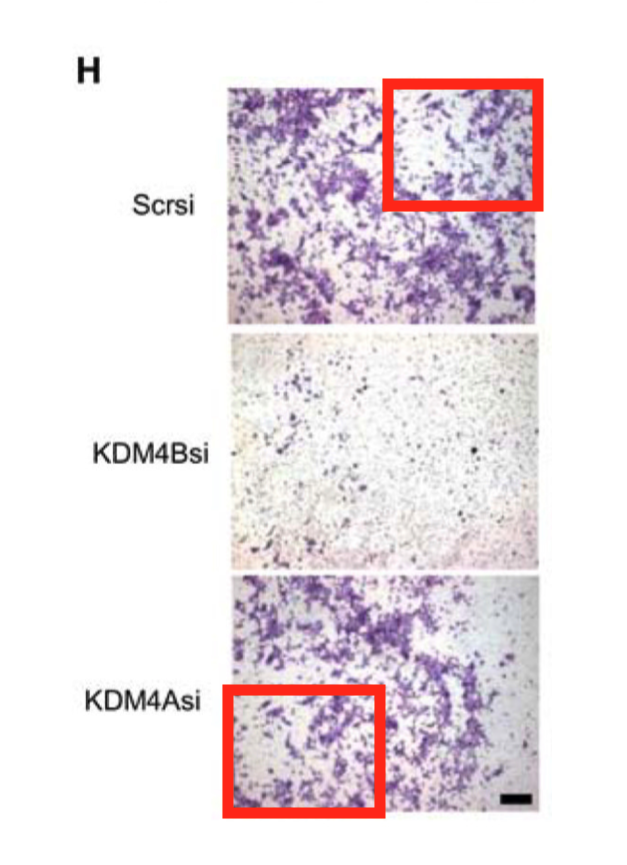
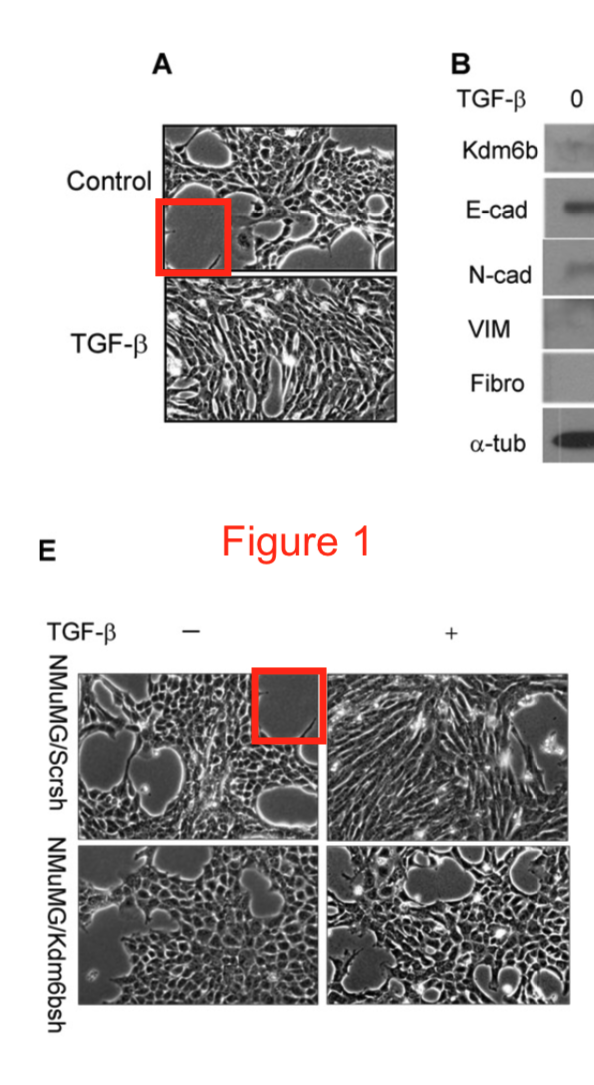
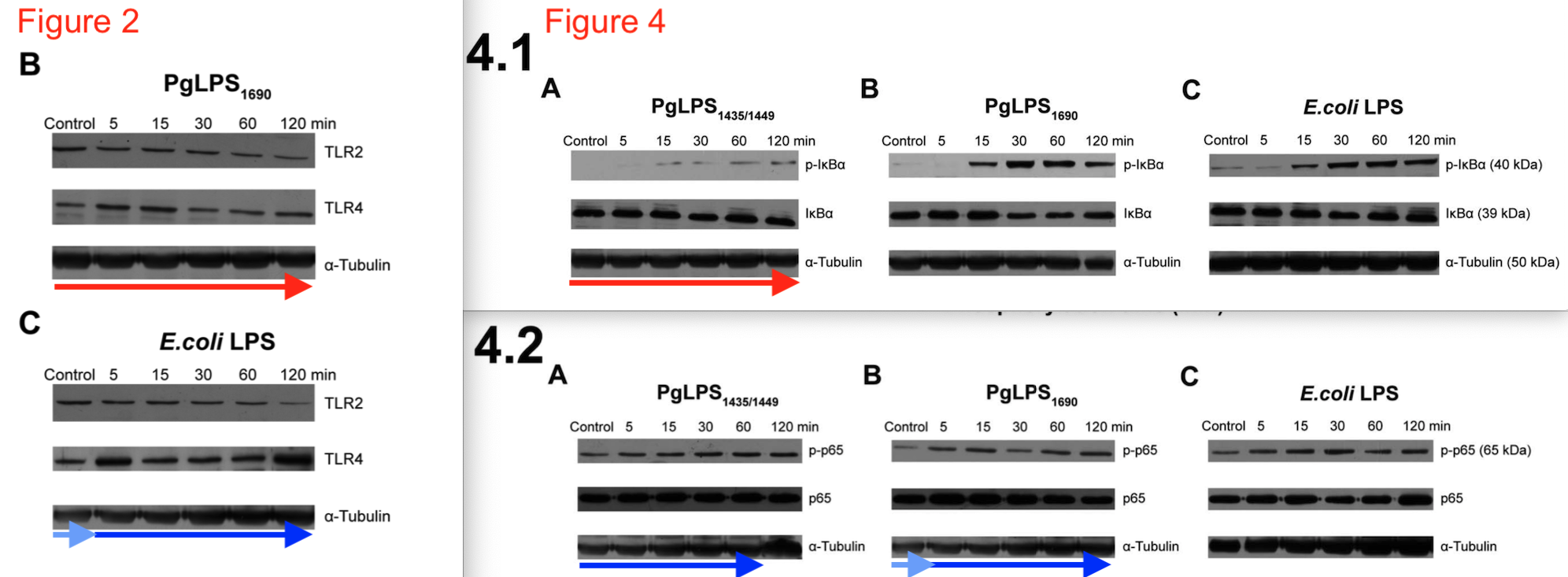
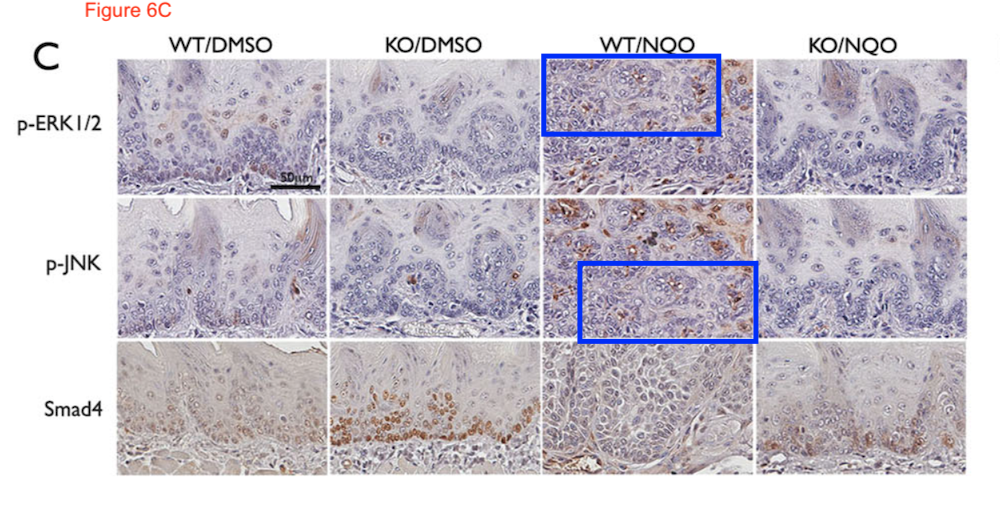

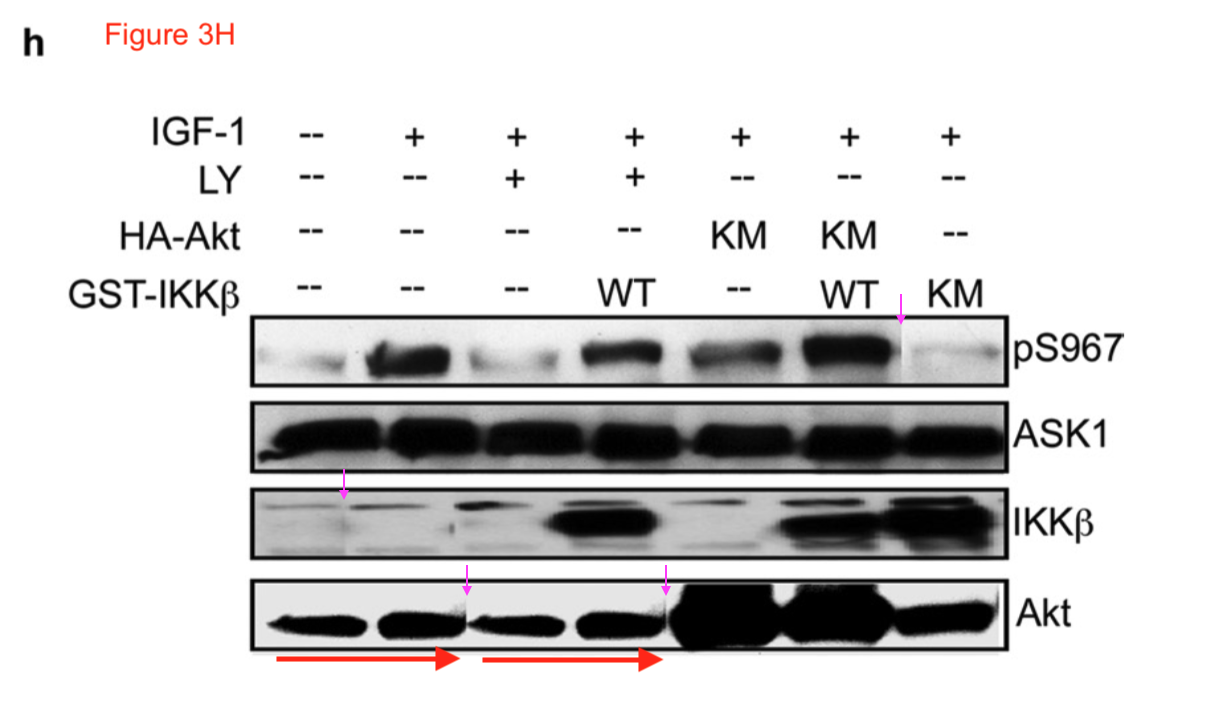
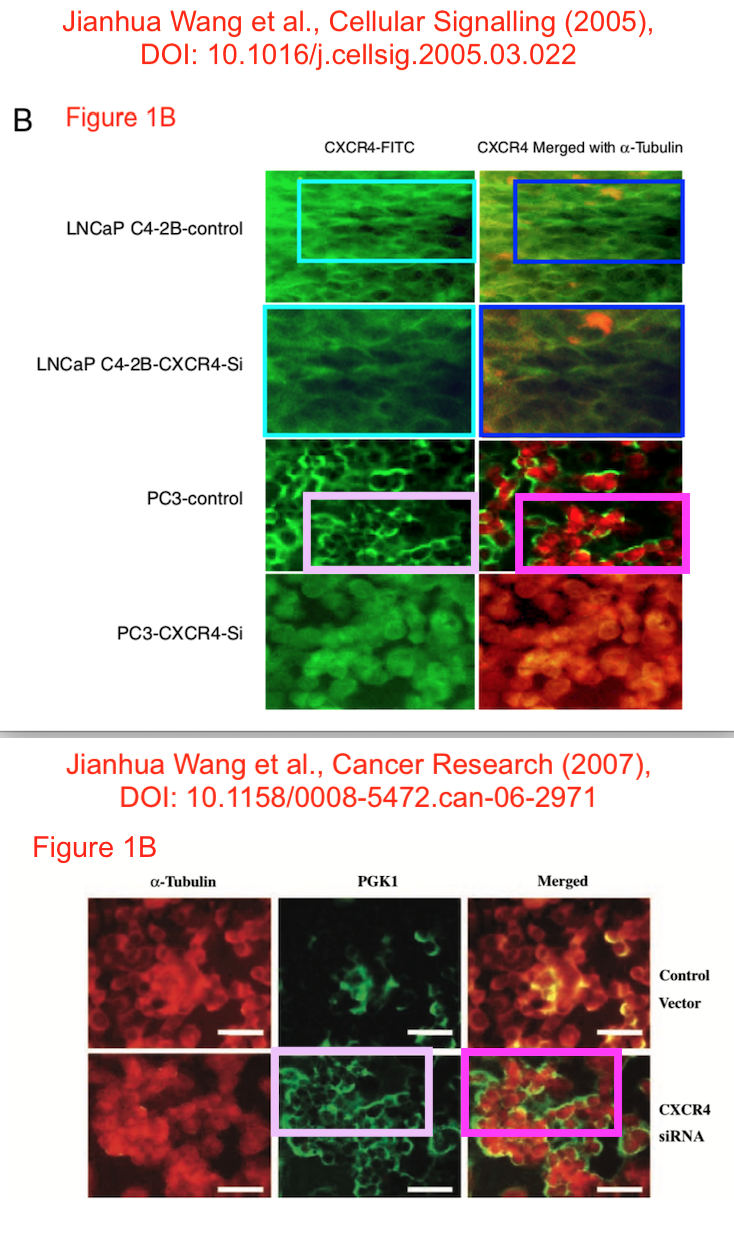
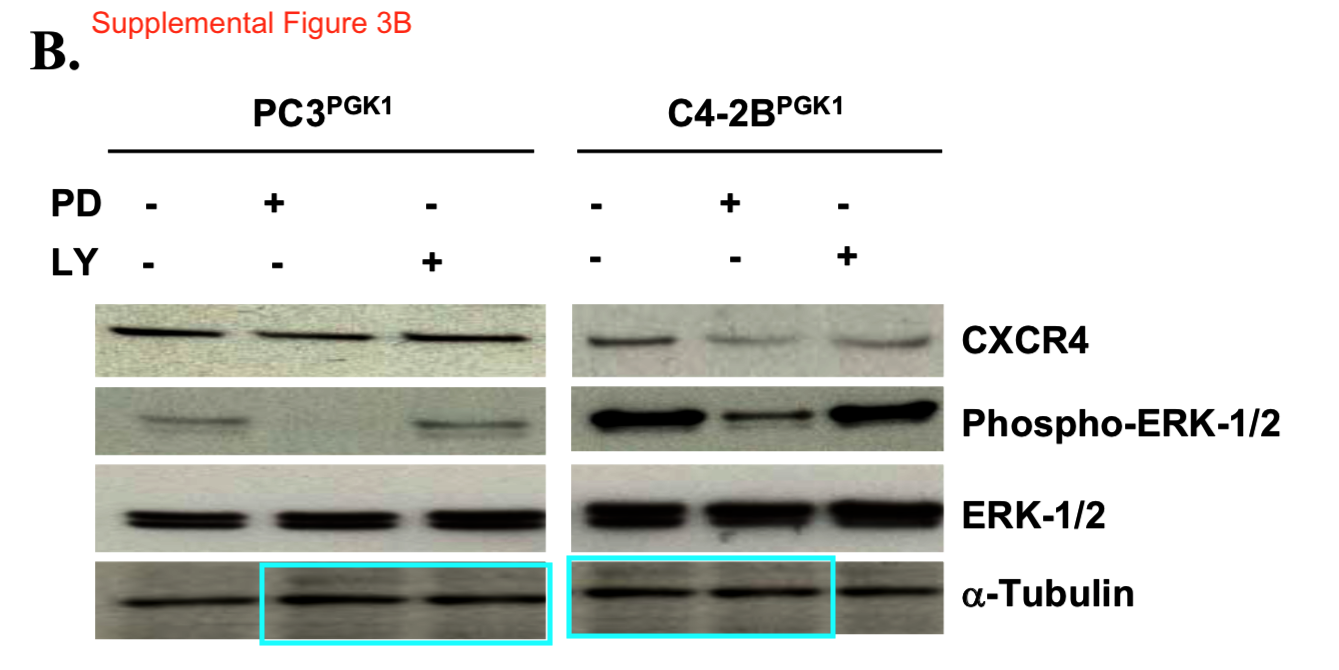
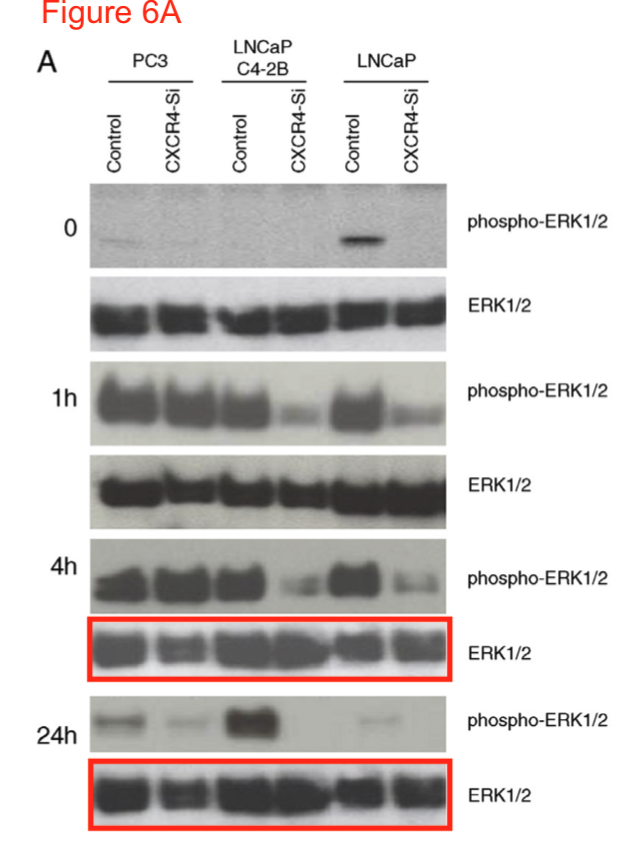

Wang’s case has been on Weibo since last Nov. It didn’t stop him from being promoted as an academic super star by his undergrad school, Nanjing Med Univ. He has numerous labs in China with names like “Wang’s Workstation”. Just count how many flagged papers have Chinese co-authors. I bet many of these papers were co-authored by his many Chinese trainees. I never would imagine anyone would be fighting to get into his team to receive his training to be a superb Photoshop geek. but look at what they turned out to be.
LikeLike
Cell Stem cell quietly asked the authors to replace the published paper with a new version, where all the manipulated figures were “fixed”. All you find in “publication history” is:
To be fair to the CSC editors, they did eventually publish an Erratum which shows the before-and-after changes.
https://www.cell.com/cell-stem-cell/fulltext/S1934-5909(18)30438-7
LikeLike
Ah, the Cell classic of hiding errata and retractions away from the main paper! Like putting up a small note in a disabled lavatory in your restaurant “btw, we pee in your food”.
LikeLike
Actually, the said whistleblower is being investigated for admission improprieties and sexual harassment among other offenses. The admission scandal took place 12 years ago (https://www.latimes.com/archives/la-xpm-2007-nov-14-me-ucla14-story.html), but the whistleblower was allowed to remain in position while conditions have not improved for the students (https://dailybruin.com/2008/05/14/dentist-resigns-post/). Recent admission scandal only brought the story back into focus (https://www.latimes.com/local/lanow/la-me-edu-cheating-university-admissions-culture-20190313-story.html). He is now being investigated and his attack on others is nothing more than a distraction/deflection tactic.
Want to know more? contact me.
LikeLike
“his attack on others is nothing more than a distraction/deflection tactic. Want to know more? contact me.” I want to know more. It is very common tactics to shift discussion from fraud to personal relations. Whatever motivation the whistleblower had, we can see here problems exposed in 7 papers. Do you think that these problems must be disregarded only because he is “bad”?
LikeLike
This is extremely bad. I think it is important if Leonid could have some sort of ‘forum’ attached to the site where people who are victims of scientific and other types of misconduct can exchange information and gang up on the perpetrators. We need all these bastards removed from science!
LikeLike
“Lady Lay”, I presume you are a UCLA dentistry faculty member, likely one of the authors of discussed papers and maybe even the person under Title IX investigation, since I am rather sure you are male.
Now, nowhere in the articles you posted here is any mention of “sexual harassment”. The college admissions scandal is known and seems to be part of a wider problem at UCLA School of Dentistry, or in fact elite universities in USA, and not of one single faculty member.
But now you utterly discredited yourself with your slander about “sexual harassment”. Nobody will contact you “to know more”.
LikeLike
“He is now being investigated and his attack on others is nothing more than a distraction/deflection tactic.” I think you described pretty much everything here. Thank you for clarifying about YOUR “distraction/deflection” tactic.
LikeLike
Agree.
LikeLike
admission improprieties and sexual harassment among other offenses
‘Sexual harassment’ is a serious accusation. Do you have any more information or evidence, other than “being investigated”?
LikeLike
The above comment was posted from:
“Lady Lay
TruthComesOut1@yandex.com
170.170.59.138″
The IP address is misdirected to FedEX in Plano Texas.
On 2.05.2019, a series of email were sent to a long list of academic recipients at different universities, attributed to me. It came from same email address as “Lady Lay” and forwarded an email from “concerned faculty” accusing the whistleblower of sexual harassment:
The email address concerned_SOD@mail.com proved non-functional.
LikeLike
Well, some gossip I overheard. One frequent co-author, Bo Yu, of Wang’s flagged papers is the son of his fellow friend Guangyan Yu, the president of Chinese Stomatological Association. Yu Senior and Wang were just 2 years apart in their DDS study in Beijing Med University School of Stomatology. When Wang went to UCLA Dentistry School to be on faculty, Bo Yu (Yu Junior) enrolled there the same year.. Yu Senior, with his enormous power and connection in China, apparently helped Wang to establish numerous “Wang Workstation” in China. Wang also opened his UCLA lab for Chinese trainees and visiting scholars. Just see how many of his flagged papers have Chinese co-authors. These papers helped established the bright career of 2 big guys there in this field in China. One of them is the dean of West China School of Stomatology, Xuedong Zhou, co-author of one of the flagged papers. Some Chinese scholars reported their fraud to their universities and only received pretty harsh retaliation. In response to the allegations of misconduct, Wang even openly said in one of his China labs that as long as the conclusion is fine, using wrong figures is no big deal.
LikeLike
Pingback: UCLA hunts whistleblowers as student accuses dentistry dean of sexual harassment – For Better Science
I worked in Dr. Wang’s lab in the past and know most people whose names are mentioned in this article. It shocks me how much truth there is to this article. The comments above about Dr. Bo Yu is true as well. But it doesn’t surprise me that the truth came to light. Even back then, I thought a lot of data in the lab was too good to be true. The results I saw from Dr. Hong’s experiments were very different from what’s in her papers. Drs. Hong, Yu, and some other people were not even in lab often enough to produce the amount of data they said they did.
It is unclear whether Dr. Wang encouraged or covered up fraudulent data, but the culture in Wang lab did foster it. Anyone who worked with Dr. Wang can attest to this. The pressure to publish at all prices was like no other lab I worked in. I want to say kudos to this site for the very detailed and accurate account of this case. Same as some other lab members, I did not dare to step up, fearing career suicide. It is not easy to prove fraud – besides the blatant errors that you pointed out, many results are observational or can be easily manipulated by using different gating strategy, data omission etc. I doubt if there is any consequence to anyone accused in this case, other than the whistleblower. All I saw was “Correction” after “Correction” – it’s amazing that the top journals allow this. In fact, Dr. Christine Hong has recently moved to UCSF with a coveted position (Graduate Orthodontics Program Director).
LikeLike
In recent days, Dr. Elisabeth Bik has posted comments for Cun-yu Wang’s following papers on Pubpeer:
https://pubpeer.com/publications/6FEFC54C57B6D1708F3D60A5229990#1
https://pubpeer.com/publications/1263C3A195DB0F54A9716F055C5A00#1
https://pubpeer.com/publications/0AFECF39789F4511F24CF8CC9B39A7#1
https://pubpeer.com/publications/870C8DCED824F287448BF00098A643#1
https://pubpeer.com/publications/3BFCA4A623CBC0B77997513F277366
https://pubpeer.com/publications/F812B34F81256487E17917D064C584
https://pubpeer.com/publications/15BDB9EC8B2E38E8A42D012280864A
https://pubpeer.com/publications/B027C161212FA54A956AACDA7EB5EF
https://pubpeer.com/publications/166417F1395B9694E692D0344E7992
https://pubpeer.com/publications/4BEC6C3B5777B534E7047C1403ECA4
One of the above was a comment of additional image irregularities in a previously corrected Wang paper.
LikeLike
I’m just gonna leave this here:
https://dailybruin.com/2020/05/27/dentistry-professor-sues-uc-for-alleged-retaliation-following-title-ix-testimony/
You misspelled Kang Ting as “whistleblower”. There is plenty of data falsification from his lab as well. Dig deeper.
LikeLike
No, you dig deeper. It is an argument of an idiot troll to say: his data is fake, and it is up to others to dig up proof. But hey, thanks for the link.
Oh look, somebody dug already:
https://pubpeer.com/search?q=cun-yu+wang
LikeLike
“13.11.2018: The whistleblower lodges a formal complaint against the dean and associate deans of the dental school with Ann Pollack, assistant vice chancellor – Research and Campus Research Compliance Coordinator regarding scientific fraud by the dean and associate deans of the UCLA School of Dentistry”
4 years have passed but Dr. Cun keeps publishing research in the same Cell Stem Cells journal.
https://www.uclahealth.org/news/researchers-id-new-target-in-drive-to-improve-immunotherapy-for-cancer
https://www.cell.com/cell-stem-cell/fulltext/S1934-5909(21)00010-2?_returnURL=https%3A%2F%2Flinkinghub.elsevier.com%2Fretrieve%2Fpii%2FS1934590921000102%3Fshowall%3Dtrue
Did the investigation even take place? Was it finished? How can a UCLA report on research misconduct allegations be obtained?
LikeLike
I found your article through the https://uclahuntswhistleblowers.com website. It is absolutely disgusting that UCLA has been able to bully down credible claims without being held accountable. Thank you for covering it.
LikeLike